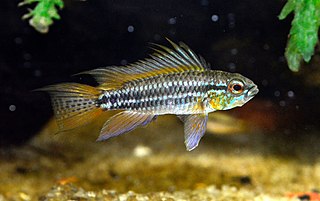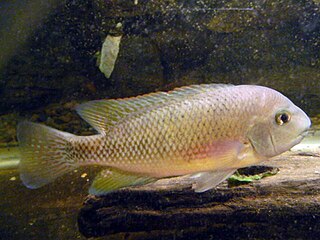
Cichlasoma is a genus of freshwater fish in the cichlid family. The genus was previously very large, including cichlids from North America, including Central America, and South America.

Crenicichla is a genus of cichlids native to South America commonly known as the pike cichlids. They are found in most tropical and subtropical freshwater habitats between the Andes and the Atlantic.

Apistogramma is a large genus of freshwater fish in the family Cichlidae native to South America, but also commonly kept in aquariums. They are dwarf cichlids that mostly feed on tiny animals and have breeding behaviors that vary depending on the exact species.

Aequidens is a genus of fish in the family Cichlidae found in South America. Formerly a wastebasket genus, as presently defined Aequidens is largely restricted to the Amazon Basin, Orinoco Basin and river basins in The Guianas. The only exceptions are A. plagiozonatus which also occurs in the Paraná Basin, and A. tetramerus which also occurs in the Parnaíba River.

Geophagus is a genus of cichlids that mainly live in South America as far south as Argentina and Uruguay, but a single species, G. crassilabris is from Panama. They are found in a wide range of freshwater habitats. They are part of a group popularly known as eartheaters and mostly feed by picking up mouthfuls of sediment to sift out food items such as invertebrates, plant material and detritus. The largest species reach up to 28 cm (11 in) in standard length. They are mostly kept in aquariums.

Archocentrus is a genus of cichlid fish from Central America. It currently contains a single species, the flier cichlid, which is found in stagnant and slow-moving freshwater habitats such as lakes, ponds, ditches, swamps and rivers in Honduras, Nicaragua and Costa Rica. It is up to 11 cm (4.3 in) long and feeds on invertebrates and detritus.

Hypsophrys is a small genus of cichlid fishes from Central America.

Laetacara is a small genus of cichlids native to freshwater habitats in tropical and subtropical South America, ranging from the upper Orinoco River basin in Venezuela to the Paraná River basin Argentina. The genus is also collectively known as the smiling acaras. Like all cichlids, Laetacara species have well-developed brood care.

Talamancaheros sieboldii, the Siebold's cichlid, is a species of cichlid fish found in fast- and moderately-flowing rivers on the Pacific slope of western Panama. The population in Costa Rica, which formerly was included in this species, is now recognized as T. underwoodi. T. sieboldii reaches up to 25 cm (10 in) in standard length and eats vegetable matter and detritus.
Cryptoheros is a genus of small cichlid fishes from Central America and southeast Mexico. They reach up to 13 cm (5.1 in) in length.

Heroini is a fish tribe from the Cichlasomatinae subfamily in the family Cichlidae (cichlids). All cichlids native to the Greater Antilles, United States, Mexico and northern Central America are members of this tribe. It also includes most cichlid species in southern Central America and several species from South America. A large percentage of its species were formerly placed in the genus Cichlasoma but have since been moved to other genera.
Rondonacara hoehnei is a species of cichlid fish of the subfamily Cichlinae. This species is endemic to the upper das Mortes River basin in the Araguaia drainage of central Brazil. This species is the only known member of its genus, but it was formerly included in Aequidens. Although not yet rated by the IUCN, it has been suggested that it is seriously threatened and should be considered critically endangered. The specific name honour the collector of the type specimen, the Brazilian botanist Frederico Carlos Hoehne (1882-1959).

Australoheros facetus, formerly Cichlasoma facetum, the chameleon cichlid or chanchito, is a species of cichlid from the subfamily Cichlasomatinae which is native to northern Argentina, Paraguay, Uruguay and southern Brazil.

Maskaheros is a genus of cichlids fish found on Atlantic slope of southern Mexico and Guatemala in the Coatzacoalcos and Usumacinta River drainages. They are relatively large, high-bodied cichlids and were formerly included in the genus Paraneetroplus or Vieja.
Kihnichthys ufermanni, the Usumacinta cichlid, is a species of cichlid found in a few rivers in the Usumacinta River basin in Guatemala and southern Mexico. It typically occurs in rivers that are about 10–50 m (33–164 ft) wide, fairly deep, have few or no aquaritc plants, and a variable water current. This species is the only known member of its genus, but several of its features, including the chisel-like teeth, are shared with Cincelichthys and whether they should be merged into a single genus is not yet fully resolved; a review in 2020 recommended that the Usumacinta cichlid should be moved into Cincelichthys. The Usumacinta cichlid reaches a standard length of 25 cm (10 in).
Chiapaheros grammodes is a species of cichlid fish found in the upper part of the Grijalva River basin in southern Mexico and far western Guatemala. Adults generally inhabit areas with moderate to strong current, but they can also be found in backwaters and juveniles generally occur in calm waters. This species is the only known member of its genus, but historically it has been placed in several other genera. It reaches up to about 20 cm (8 in) in standard length. C. grammodes is relatively aggressive and quite predatory, tending towards piscivory. Both natural and aquarium hybrids have occurred between this species and Vieja hartwegi.
Chocoheros is a monotypic genus of cichlid. Its only known species is Chocoheros microlepis, found in South America. It is endemic to the single river basin of Rio Baudó on the Pacific side of Colombia.

Talamancaheros is a genus of cichlid fish found in fast- and moderately-flowing rivers on the Pacific slope of the Talamanca mountains of Costa Rica and western Panama. Talamancaheros reaches up to 25 cm (10 in) in standard length.

Mayaheros is a genus of cichlid fish that is native to Mexico and northern Central America. This genus has a disjunct distribution, with the M. urophthalmus group being found in the Atlantic drainages of southeastern Mexico, Belize, eastern Guatemala, northern Honduras and northeastern Nicaragua, while M. beani is the northernmost cichlid in the Pacific drainage, ranging from Jalisco to Sonora in northwestern Mexico. Both inhabit a wide range of habitats such as freshwater rivers, streams, lakes, ponds, pools and marshes, as well as brackish waters like estuaries, lagoons and mangrove, with members of the M. urophthalmus group sometimes even occurring in caves or coastal marine waters. They are medium-sized to large cichlids that are omnivorous, feeding mostly on small animals, but also plants and detritus.

Cichlastomatini is a tribe of cichlids from South America, one of two tribes that make up the subfamily Cichlasomatinae. They were recognised in 1983 as an assemblage by the Swedish ichthyologist Sven O. Kullander by their four rather than five 5 dentary foramina in the lateralis canal system of the head, describing them as closely related to the genus Cichlasoma. Melanie Stiassny suggested that these fishes recognised as a clade by Kullander were divided into two groupings in 1991 which she termed cichlasomines and heroines, Kullander formally raised these to the tribes Cichlasomatini and Heroini of the subfamily Cichlasomatinae in 1999. In other classifications the tribe Cichlasomatini is placed in the subfamily Cichlinae.














